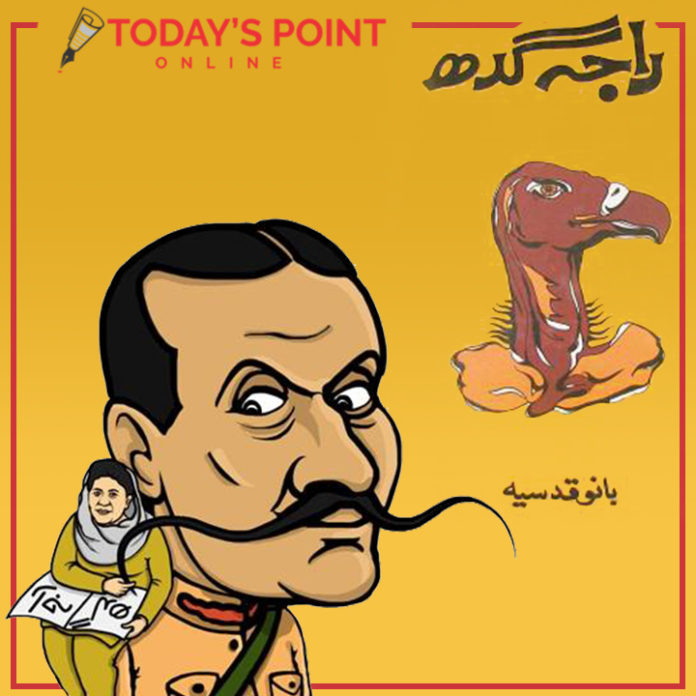From Viewpoint Archives, 2014.
Two decades ago when I arrived Punjab University, two titles were a must read. Students with a progressive bent of mind read and discussed Raja Anwar’s ‘Jhotay Roop Kay Darshan’ (Glimpses of Fake Beauty), a collection of beautifully-versed love letters. I am not sure if this title still travels hostel-room to hostel-room on the university campus, but the author of the book, ironically, has abandoned the views he preached in his book with a messianic passion.
The subject of my essay is Bano Qudsia’s novel ‘Raja Gidh’ (The Vulture King), read and passionately discussed on campuses and beyond. Last year, while waiting for the train at the Lahore railway station, I noticed the title at the local bookstall. Out of curiosity, I began to skim through the book. Dedicated to ‘Qudrutullah Shahab’, the notorious ‘sufi-bureaucrat’ in the service of military dictatorships, the copy in my hand was a sample of the 30th edition published in 2012. The first edition went to press in 1981. In other words, there has been one edition every year since. I bought the copy and re-read it on my way to Karachi. Honestly, when I read it for the first time as a college student in 1991, I was mystified. This time I was horrified but not because of the reactionary ideas presented in the novel. I hardly expect anything optimistic from Qudrutullah Shahab’s disciples. That this novel continues to hold sway over popular imagination is what I find horrifying. But this is understandable. In a period of reaction, reactionary texts stand a greater chance of becoming popular or in this case maintaining popularity. Reactionary times reinforce the popularity of the reactionary texts and vice versa. For those who are unfamiliar with the text, let me briefly recap the plot.
The story of Raja Gidh: This tale revolves around four central characters: Professor Sohail, who teaches Sociology at the Government College Lahore, and three of his students, Seemi Shah, Qayyum and Aftab Butt. Professor Sohail is hardly six years older than his students yet ‘he in his possession has sort of a flog that trainers use to train the lions. He was not good at convening an academic course yet he was good at the martial arts of minds . His favourite pastime was arranging wrestling between various ideologies. He liked to dig open the brains of his students. On finding them empty, he would love to let them be empty. He knew how to make such students speak who were shy of speaking while he could equally efficiently shut the mouths blabbering like a radio set. He was never shocked by anything. Not merely sociology, he was good on any subject in the world. Therefore, in his presence, the atmosphere did not carry the superficiality of educational aura’ (p9).
Seemi Shah, westernized in her mannerisms and dress, is a product of Lahore’s elitist ‘culture of Gulberg’. A not-so-handsome Qayyum hails from a Sheikhupura village. He is a bookworm while Aftab Butt is a scion of an elite Lahori family from the Walled City. Along with his film star looks Aftab (Sun), a leader of the student union is charming by virtue of his intelligence. The three young sociology students are tied into a love-triangle while Professor Sohail is the geometrician behind the triangle. As happens in Bollywood productions, the ‘daughter of Gulberg who would take shower with back brush somehow surrendered her heart before a Kashmiri kid, that too from Walled City’ during the very first day of their MA course. It happened, of course, during Professor Sohail’s lecture. ‘While they had been stealing glances at each other the day they came to college to submit their admission applications or passing by each other in the college corridors’, however, during the lecture delivered by Professor Sohail, ‘their eyes were first overtaken by a surprise, then a familiarity developed between the two, and in one session it all ended up in a confession . After the lecture, both left the class room; as if in a drunken stupor both were walking together; reaching outside the college building Seemi Shah without saying anything hitchhiked with Aftab on his motorbike’ (p15).
Meantime, Qayyum is also madly in love with Seemi and is jealous of Aftab. Incidentally, Aftab and Qayyum are hostel roommates but they are not friends. They never speak about Seemi. One day, Qayyum finds out that Aftab is engaged to a cousin and views this as an opportunity. Aftab marries his cousin and leaves for London, without completing his course. Seemi, heartbroken and dejected, moves to Rawalpindi. She is unable to forget Aftab and keeps travelling to Lahore so that she can meet Qayyum and talk about Aftab. Such is her passion that she establishes a physical relationship with Qayyum thinking that Aftab and Qayyum being roommates might have been in a gay relationship. After all boys while living in hostels become homosexuals (p118).
A digression: I wonder if the Changez-Erica affair in Mohsin Hamid’s The Reluctant Fundamentalist is a plagiarized version of the Seemi-Qayyum relationship described in Raja Gidh. Or is it a sweet coincidence that Bano Apa and Mohsin Bhai have conceived similar love tragedies. I will not suggest that Bano Apa drag Mohsin Bhai to court on the charge of plagiarism. She must decide for herself.
Like Erica, Seemi Shah commits suicide. Seemi’s suicide drives Qayyum to the point of half-madness . By chance, one day Qayyum happens to meet Professor Sohail. The professor advises Qayyum to practice Tantric Yoga. Again, as chance would have it, Qayyum’s distant relative Abida arrives in Lahore from Chichawatni to stay with Qayyum’s family. She wants a divorce because her husband is not able to father a child and she desperately wants a child. Since Qayyum needs a sex partner to practice Tantric yoga, he seduces Abida on the plea that she would become a mother. Abida, who is a religious person, surrenders herself for a while. However, she is uneasy with the relationship and finally returns to her husband. Meantime, Qayyum finds a job at Radio Pakistan where he comes across Amtal, a red light area woman.
Now forty, Amtal is at an age where she is able neither to sell her voice nor her flesh. Qayyum and Amtal develop a liking for each other, but are not able to develop a physical relationship. One day, Amtal’s prayer is blessed and she is killed by her own mentally-challenged son.
Qayyum, lonely and upset again, finally agrees to marry a girl of his family’s choice. His only condition is that the girl should be a Baqira . Roshan, a girl from the Walled City, is selected. However, on the wedding night, Roshan tells Qayyum that she is already pregnant. Before marriage she was in love with Iftikhar, a man who lived in her neighbourhood. Her family disapproved of the relationship. Iftikhar was forced to leave for Saudi Arabia.
Qayyum is not Manto’s character. Instead of kissing Roshan’s swollen belly, he sends her to the holy land of Saudi Arabia where she re-unites with Iftikhar. Despite her sins, Roshan is redeemed through Saudi Arabia. Qayyum’s growing ‘Pagal Pan’ apparently a result of unrequited love-affairs, requires a ‘Sufi’ solution. Bano Apa sends him to ‘Sain Jee’ in the company of Professor Sohail. Sain Jee commands such metaphysical powers that ‘he can lift the veil of death and show you the other world’ (p418).
He can summon a spirit and is capable of uncovering the thoughts seated in the darkest corners of one’s mind. Qayyum wants to meet Seemi’s spirit. Sain Jee is powerful but his powers are not limitless. ‘He can arrange meeting with spirits of dead people only if the image of dead person’s grave is in the mind of person interested in meeting the spirit’ (p 424). Qayyum does not even know where Seemi is buried. Sain Jee is a hybrid of Baba Wasif Ali Wasif and Baba Yahya. A Sain Ji with restricted mystical powers offers atheists a chance to mock Bano Apa’s ‘Sain Ji’. Hence, Sain Jee, promises to find a solution. By chance, as tensions and suspense peak, the day Qayyum arrives at Sain Jee’s secluded dera to meet Seemi’s spirit, Sain Jee ‘disappears permanently’ ( ‘saints’ do not die, they ‘disappear’].
Behind all the ‘chance’ happenings, there is a grand scheme. The grand scheme in turn is neatly located in a grand theory. Ji Haan! The theory of Halal-o-Haram (Kosher and Forbidden)!
Lavishly described (pp 274-281), the Theory wants us to believe that Haram and Halal acts literally penetrate the genes of future generations. ‘Pagal pan’ is caused by Haram genes. Once condemned to carry Haram genes, s/he is destined to live the life of a ‘vulture’; a bird that lives on dead meat. According to Sharia, the ‘dead meat’ is not Halal. However what fascinates her readers is the attempt to lend her ‘theory’ of Halal and Haram a ‘scientific’ aura.
Pressing science into the service of absurdity: Bano Qudsia Islamifies Eugenics (pp 66-67, 111,142,149, 337, 342-43, 361, 444) and presses Eugene’s racist crackpot-science into the service of her anti-science theory. However, when wrapped in Islamified-Eugenics, the characterization of Qayyum is justified.
Qayyum’s mother eloped with his father, Maqsood. Incidentally, both met at Baba Bulleh Shah’s shrine. In other words, like Wahabis, the puritan literary mystics organized around a ‘sufi-bureaucrat’, and benefitting from military dictatorships, find Bulleh Shah’s shrine an impure place. Not so incidentally, Punjabi progressives glorify Bulleh Shah as a symbol of resistance to tyranny.
Elopement delineated in Raja Gidh, springing from Bulleh Shah’s shrine, is not sanctified through Nikah (marriage) as often happens in real-life Punjab in the countryside. Instead, it vulturises into a triangle of sin. Maqsood’s cousin who resides with him also establishes relations with an eloped woman.
We are implicitly told that Qayyum is a bastard child fathered by this cousin-uncle. On top of that, Qayyum is Rajput by caste. Rajput warriors from Rajasthan, in the business of plunder and massacre for centuries, settled in Punjab. For centuries, Rajput plunder entered as Haram genes in Qayyum’s body, determining his vulture-like nature.
As a result he is condemned to a life of preying upon ‘dead meat’. He is condemned to prey upon the Westernized Seemi Shah who loves Aftab or Abida, who commits infidelity by betraying her husband. However, when he attempts to go Kosher , fate denies him the pleasure. As far as Amtal is concerned, because she is a red light woman she is herself a ‘vulture’. For generations, she has carried the Zina genes. Understandably, her son suffers from ‘Pagal Pan’. However, ‘Pagal Pan’ is not always a punishment visited upon children for sins committed by their parents.
Aftab’s son, born in London, also suffers from ‘Pagal Pan’. However, his ‘Pagal Pan’ is a blessing: through his insanity this child can communicate with metaphysical powers. While Amtal’s son is a killer, Aftab’s Islamified son recites Azan and is very religious. With the looks of a Greek God, Aftab is Qayyum’s nemesis. However, there are no clues in Raja Gidh regarding whether Aftab’s family run carpet business employs child labour or not. Similarly, there are no clues regarding the plight of carpet workers. But then the exploitation of workers or child labour is not enough of a sin to corrupt the genes.
This theory of Halal and Haram was marketed at a time when the country was suffering under the jackboots of a puritan military ruler, who was in the habit of offering highly-publicized Istikhara prayers, while Bhutto-era workers’ friendly reforms were being rolled back. Needless to say the attacks on women’s rights and religious minorities increased during this period.
Likewise, it was a time when the country’s top scientist advocated the harnessing of Djins’ untapped powers to generate electricity .
The publication of Raja Gidh, viewed in the context of the Zia dictatorship, assumes a highly political character. It would be a very cute coincidence if we believe the members of ‘Shahabia sect’, Bano Qudsia and her husband Ashfaq Ahmed, the most prominent among them, were ‘incidentally’ propagating Halal ideas under the kosher dictatorship of Zia-ul-Haq. It was a dictatorship that jailed Jalib, forced Faiz, Fraz, and Fehmida Riaz into exile and permitted the flogging of four brave journalists (Khawar Naeem Hashmi, Masoodulla Khan, Nasir Zaidi, Iqbal Jaffari). But disciples of Mr. Shahab were duly patronized all these years.
In fact, what Raja Gidh, along with state-sponsored/state-patronized cultural production, did at the time was to rationalize reactionary rightwing politics that ultimately led to present-day Talibanisation. Not surprisingly, Raja Gidh’s discourse on women and communists for instance sits neatly with Zia-era politics.
Raja Gidh’s anti-communism: The discourse demonizing communists begins from Page 18. However, instead of questioning the tenets of communism, she resorts to familiar Jamaat-e-Islami tactics. On the one hand, she points out the contradictions (hypocrisies) marking the lives of communists. ‘Professor Tanvir’, Qayyum’s BA teacher, personifies Bano’s demonized communist. Thus Qayyum describes his BA teacher, Professor Tanvir: “I met him during the first year of my BA.
He would always smoke imported cigarettes, always dress in a three-piece suit. The bespectacled professor would conduct our tutorials besides delivering lectures. That he was well read inspired me . Since my education had taken place on the countryside, therefore, I had inkling for feudalism. He staunchly believed in socialism. Theoretically, he would assign every problem to an unequal distribution of wealth…However, he was only a bookish socialist. His lifestyle, even in its minute details, mirrored feudalistic style. The real problem was his lack of tolerance for any criticism either on his creed or his lifestyle…A few days ahead of our BA exams, he allowed us to smoke in the class room to establish his progressivism .
One day I stood up and asked, ‘Sir! May I ask a question’.
‘You do not have to stand up. We are all friends here. You need not extinguish your cigarette either’, he said.
I said, ‘Sir! You daily tell us that capital is the root cause of Third World’s zilat . Why don’t you sell your car and buy a motorbike.’
I was not yet mature enough to understand that the lives of towering personalities are marked by contradictions. Professor Tanvir went red with rage. He composed himself and said, ‘This is very personal question. You country side folks lack good manners. You donkey – how would I come to college if I sell my car?’
My ego had been hurt. I, therefore, refused to give up the debate. To corner him, I said, ‘you can cycle to the college…one should rub shoulders with ordinary folks.’
‘You donkey of a man! This is space age…we need to save time. You want me to ride a bike.’
‘Sir! But China is also into space age. The Chinese…’
‘An intellectual and professor should ride bicycle…while your businessmen, factory owners, nouveau riche should ride cars’.
‘But you do not believe in classes. How come you assign status to classes’, I said.
Professor was foaming with rage now. Waving his arms, he said, ‘Sit down you frog! With your two-and-a-half inch brain, you cannot understand Marxism’ (p 18-20).
On the other hand, Professor Sohail is also a self-styled ‘communist, an atheist, and a lover of the prophet, all at the same time’ (p240). But a communist, who by the end of novel, sees the light and owes allegiance to Sain Ji.
At one point, even Qayyum is described as a socialist. However, as usual he is a bookish socialist as well, unable to understand the problem of hunger (p 83). .
Another ‘socialist’, briefly introduced is, ‘Haider’. Briefly because Seemi Shah let him prey on her dead meat at a certain moment. As usual, “Haider and his ideology-fellows rebel against their parents…But temporarily. Unlike old-fashioned people, they hurriedly reconcile with their rich parents because they cannot live without the luxuries of life. They are socialist in talk, bourgeois in their lifestyles”
What is their lifestyle? “Inside the boundaries of their homes, they enjoy HiFi music, enjoy the company of girls, explore US magazines, give long telephone calls, and engage in meaningless chatter. When they go out, they go for hamburgers, cold coffee, disco music, motorbike rides, porno literature’ etc.
One really wonders if it is a metaphysical coincidence that every Red in Raja Gidh is a bourgeois hypocrite. At the time Raja Gidh went to press, thousands of students and activists, inspired by Marxist ideas, were heroically resisting the Zia dictatorship. Some of them courageously embraced martyrdom. Razak Jharna, for instance, walked to the gallows chanting, ‘Long Live Socialism’. Nazir Abbasi was tortured to death in a khaki dungeon. Comrade Jam Saqi became a household name by virtue of his heroic struggle. Professor Jamil Umer, who recently died, was tortured and spent years in jail for his struggle against the Zia dictatorship.
But, godless communism is not the only problem. The immoral ‘West’ is equally hopeless, being morally corrupt and lacking authentic spirituality. The real villain, however, besides the Reds, is our own ‘Westernized woman’. Seemi, personifying the ‘Westernized’ woman, not merely met a bad end ; she is a woman with questionable morals.
Her body is a commodity she can trade on many questionable pretexts. She is sexually frustrated (p48). ‘In fact, westernized education had taught her a unique form of fidelity which is engraved in her spirit . She did not mind about bodily relations’ (p112). She is belligerent, scantily dressed, and a fashionable woman who can deliver speeches at student union elections and wave flags (p 120). ‘Sometimes, modern girls like Seemi do not even realize that they are cursing themselves’ . ‘Modern girl does not know how to control her emotional life (p 179). ‘The educated girls can destroy themselves in the pursuit of their zid (p 183). Highly educated women are liars (p59). Educated girls, once out prove very cruel (p 187). And to deal with such women, nature has a solution. The ‘vulture kings’ sorts them out (p191). The entire text is studded with such feminist gems.
Is there any redemption? Yes, it lies in mysticism as personified by Sain Jee. To lend an aura of spirituality, the entire text is laced with characters such as the divine Baba Jis, instances of visions, djins, and the power of dua . To lend authenticity, she presses crackpot science in the service of her phony theory. But science is soon cast aside. There are certain exceptions to scientific rule she painstakingly elaborates. For instance, prophets and martyrs are exceptions to her theory of Halal and Haram because their food reaches them in some divine way which as human beings we cannot understand (p281).
What lessons should we draw? First: Do not protest as Aftab tells Qayyum, ‘I oppose agitation. Agitators spoil the milieu for every one’. Seemi is the agitator, self-destructive and spoiler (p 66).
Secondly, do not challenge the status-quo. Everything is predetermined. It is in our genes. We cannot escape the sins of our forefathers. Those questioning the status-quo are mere hypocrites. In fact, true communists such as Professor Sohail seek truth through ‘mysticism’.
Thirdly, Westernized women constitute a threat not merely to the society but to themselves too. By sheer coincidence, it was a bunch of Westernized, highly educated women organized in the Women Action Forum, as well as journalists, who challenged the Zia dictatorship in its initial years.
Fourthly, evil is reduced to the notion of sin. Moreover, sin is presented as an individual’s act. While her theory can be invoked to advocate General Zia’s Hadood Ordinance , her understanding/conceptualization of corruption very much precedes PTI’s/AAP’s notion of corruption. It is an individual act. There is no institutional/structural corruption, the military dictatorship, class system, gender oppression etc, do not count in this ‘Theory’. While she takes into account martyrs and prophets to rescue her Theory, she does not talk about rape. If the victim of rape is a sinner? Ironically, if one goes by her Theory, LGBT relations will constitute the safest form of sex.
Finally, it is an attack on reason, enlightenment values, science and rationalism. She invokes crackpot science to discredit science. Moreover, she massages Islamified-Pakistani narcissism by showing that western science is no match for ‘mysticism’ . Thus, in the garb of mysticism, it is an attack on the humanist and non-conformist Sufi tradition symbolized by dissidents such as Baba Bulleh Shah, Sarmad Shaheed and Shah Hussain. In fact, the ‘Sufi’ in Raja Gidh, as is the case with the disciples of Qudratullah Shahab, is a mullah in the service of the Zia dictatorship.
If anything, if Jihadi outfits and media mujahideen constitute the political and intellectual remnants of the Zia dictatorship, Raja Gidh, like other works from the 1980s by the disciples of Qudratullah Shahab, should be counted as literary remnants of the Zia period.
Also Read: A Letter to Maulana Tariq Jamil on Coronavirus









Sir this is a great peace of writing ,and is quite balanced as well as highly knowledgeable for me like students
This is a great piece of criticism based on facts and views robustly balanced.Apart from it it also a huge effort to make me like students aware of the tactics of pampered writers.
The writer of this article does not know what is literature? And what is the art of writing novels?. I am certain that he is prejudiced, and without having much knowledge of novel writing had embarked on criticism.
Comments are closed.